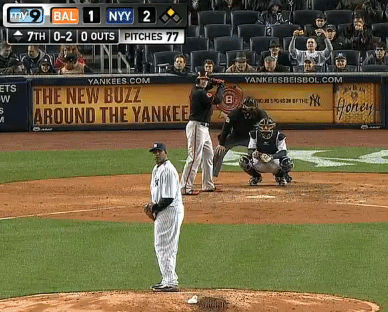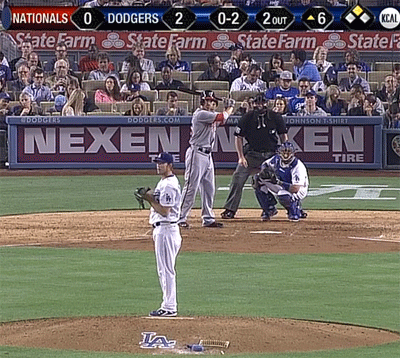In last week's edition of Raising Aces, I covered those pitchers who have been especially vulnerable versus left-handed bats, noting the tendency for pitchers with large splits to share a mechanical trend toward a low arm slot. The list was naturally populated with right-handed pitchers, with the notable exception of Ricky Romero, and one would expect to see the reverse trend this week as we examine the other side of the platoon split and study pitchers who are exceptionally tough on left-handed batters.
|
Split |
K % |
BB % |
|||
|
RHP vs RHB |
.251 |
.308 |
.396 |
20.4% |
6.7% |
|
LHP vs RHB |
.263 |
.328 |
.426 |
18.3% |
8.4% |
|
RHP vs LHB |
.260 |
.332 |
.416 |
19.0% |
9.3% |
|
LHP vs LHB |
.232 |
.294 |
.353 |
23.3% |
7.1% |
The above stats from the 2012 season reflect the reality that a lefty-on-lefty match-up confers the ultimate mound advantage. When left-handed hitters face-off against southpaw pitchers, they post the worst numbers for K rate, batting average, on-base percentage, and isolated power among the four match-up scenarios. The impact of these platoon patterns can be felt throughout baseball, and the jobs of countless LOOGYs hang in the balance.
Following the rules of last week's study, the list below presents data from 2011 through May 15 of this year, restricting the sample to those pitchers with at least 1500 opponent plate appearances over that span (with a qualifying sample size of 70 pitchers). The players are sorted according to the greatest disparities in strikeout rate when facing left- and right-handed batters, with the most successful lefty-killers atop the chart.
The following stats were calculated as (LHB – RHB). Negative values represent a lower mark against left-handed batters as compared to right-handers.
Lefty-philic Splits
|
|
K rate |
BB rate |
O-SLG |
O-PA |
|
CC Sabathia |
15.0% |
-2.3% |
-.047 |
2068 |
|
11.4% |
-4.4% |
-.213 |
1827 |
|
|
11.1% |
3.3% |
-.043 |
2055 |
Unsurprisingly, the top of the list is saturated with southpaws, and it features a couple of the usual suspects when rounding up any collection of the top pitchers in the game. CC Sabathia sits on top with a 15-point bump to his strikeout rate when facing bats from the left side, as well as peripheral numbers that further substantiate his southpaw suppression. Joe Saunders is a bit of a shock at no. 2, and the most alarming statistical blip is his greater-than-200-point disparity in opponent slugging percentage. The thought of facing Clayton Kershaw invokes night terrors for any batter, but the only recourse against him for left-handed hitters, aside from a well-timed off day, is to take enough pitches to earn a free pass.
There is an enormous gap between the top three pitchers and the rest of the list, with more than three percentage points separating Kershaw from fourth-ranked Paul Maholm, and another full percent between the Braves southpaw and the fifth-ranked C.J. Wilson. It should be noted, however, that there was not a single pitcher on the lefty-phobic list who cracked a 10-percent split for K rate in the opposite direction, and Maholm's 7.8 percent advantage versus lefties is on par with the split-advantage of last week's second-ranked Jeremy Hellickson and third-ranked Max Scherzer when they are facing right-handed hitters.
Sabathia
|
|
K rate |
BB rate |
O-SLG |
O-PA |
|
LHB |
34.5% |
4.1% |
.341 |
516 |
|
RHB |
19.5% |
6.4% |
.388 |
1552 |
Sabathia has strong mechanics and a deep release point, adding to his command and deception, which combine with the action on his slider to make left-handed hitters look foolish. Sabathia is afforded the opportunity to face lefties only one-fourth of the time, as managers throughout the league are wary of his skills. He maintains an excellent K-to-walk ratio of three-to-one against right-handers, but that number soars above eight-to-one when lefties dig into the batter's box.
Sabathia is essentially a three-pitch pitcher, but his changeup is a tool used only against batters who carry the platoon advantage. In fact, of the 5375 pitches thrown by Sabathia versus lefties since 2007, just 13 of them were changeups, according to BrooksBaseball.net. He throws fastballs and sliders to lefties, with the breaking ball making up 42 percent of his offerings—a rate that skyrockets to 60 percent when he gets two strikes on a like-sided batter. Sabathia’s ridiculous slider whiff-per-swing rate of 48 percent results in a profusion of strikeouts.

Left-handed batters are putty in Sabathia’s hands despite his simplistic approach to pitch selection, as the fastball and slider look so similar out of his hand that batters struggles to identify the incoming pitch by the time they have to initiate the swing. Sabathia’s deep release point and overall mechanical consistency allow him to disguise what's coming until it's too late for a batter to adjust, as Chris Davis found out in the above clip. Sabathia has great balance and plus posture, and though he may have a lower-than-average arm slot, his pitch trajectory is not so extreme as to set off the alarms that sounded with the low-slinging pitchers who appeared on last week's platoon chart.
Saunders
|
|
K rate |
BB rate |
O-SLG |
O-PA |
|
LHB |
22.1% |
3.3% |
.276 |
389 |
|
RHB |
10.7% |
7.7% |
.489 |
1438 |
The disparity in Saunders' numbers is nothing short of striking. Though he has no problem quieting left-handed bats, the extreme platoon splits in his statistical profile have more to do with the fact that he gets ripped apart by right-handed batters. Opposing managers have taken note: just 21 percent of Saunders' plate appearances have been against lefties since 2011, and his struggles against right-handers have dominated his overall stat line.
Like Sabathia above, Saunders leans on his slider as his primary weapon to generate strikeouts, with a 20 percent whiff rate on sliders compared to a swing-and-miss frequency of 6.3 percent or less for each of the other pitches that he brings to the table. He goes from a seven-K-per-walk monster against lefties to a pitcher with a 3-to-2 ratio versus right-handed hitters. Over the years, Saunders has thrown breaking balls on one-third of his pitches to same-sided bats, yet his slider frequency versus righties is just one percent, while his curveball rate is cut nearly in half (from 20 percent to 11 percent). Saunders’ slider is delivered with more lateral movement than vertical, giving right-handers a long look at the baseball on the rare occasion that Saunders tries to sneak one past the hitter.

Lance Berkman absolutely crushed this slider he saw from Saunders last Friday. Though Berkman held the platoon advantage in this at-bat, the switch-hitter also has a career slugging percentage that is 164 points higher when batting on the other side of the plate. Berkman has slugged just .437 against lefties in his career, but he had no problem putting this pitch over the wall in Safeco.
Kershaw
|
|
K rate |
BB rate |
O-SLG |
O-PA |
|
LHB |
35.5% |
9.2% |
.269 |
380 |
|
RHB |
24.4% |
5.9% |
.312 |
1675 |
If opposing managers are stacking their lineups with right-handed hitters to pursue the platoon advantage against Saunders, then they’re flat out avoiding Kershaw at all costs with their lefties. The Dodger ace has faced just 18.4 percent left-handed batters during his two-plus year reign as the NL ERA king, and though he has the capacity to make any hitter look foolish, he has completely nullified batters who have to see his stuff break away. Kershaw's curveball and slider both grade out as plus, and he can use either pitch to induce ugly swings. The numbers against right-handers are Cy-worthy on their own, but Kershaw’s absolute domination of those who attempt to step on his side of the platoon is unparalleled: his lefty K rate was the highest in the sample, and his opponent slugging was the lowest. Those rankings remain intact even after lowering the O-PA threshold to 1000 (sample size n = 133).

Kershaw rarely uncorks the slider against righties, but the above slide-piece was able to coax an empty swing from MVP candidate Paul Goldschmidt. Goldschmidt's reputation for southpaw destruction is well-earned, with a .599 slugging percentage versus lefties during his brief career. Oddly, Kershaw has posted a superior walk rate against the right-handed bats he’s faced when compared to opposing lefties, despite the fact that he relies on a similar pitch mix regardless of hitter handedness. In fact, the biggest disparity in his pitch selection portfolio, albeit by just seven percentage points, is a tendency to throw more four-seam fastballs with lefties at the plate, which is the opposite pattern that one would expect when looking just at the numbers.
In my recent article about the best stuff in the majors, I had trouble deciding which Kershaw breaking ball to choose, as both the slider and the curve were worthy for inclusion on their own merits. I captured video for each of the 11 strikeouts in his May 14 game against the Nats, and since the vast majority of his whiffs came on curveballs, I chose good old Uncle Charlie for the breaking ball nominee. Ten of those 11 K's came against right-handed batters, but Kershaw also used the curve to take down the lone lefty in the Washington lineup, striking out Adam LaRoche in the sixth inning.

The breaking ball might be his finishing move, but Kershaw relies heavily on the fastball early in the count against batters on both sides. He goes to the heat 80 percent of the time on the first pitch or when behind in the count, situations in which he keeps his curveball locked in a cage, but his hammer is a force to be reckoned with once the count swings in his favor. Kershaw has had an over-the-top delivery throughout much of his career, and though his postural stability is steadily improving over time, nobody would make the mistake of including him as a point in favor of the theory behind low arm slots triggering vast platoon splits.
***
Honorable Mention
|
|
K rate |
BB rate |
O-SLG |
O-PA |
|
18.3% |
-4.0% |
-.181 |
740 |
|
|
5.3% |
1.7% |
-.059 |
1899 |
With less than half of the opponent plate appearances necessary to qualify, Brian Matusz fell short of inclusion on the master list of lefty-killers, but his strikeout-rate discrepancy of 18.3 percent was by far the highest among pitchers with at least 700 O-PA. Toss in a huge drop in opponent power when facing port-siders (ranked fourth), and you have a former first-round pick whose future may be as a major-league LOOGY.

Dan Haren's platoon split for K-rate was the highest-ranked among right-handed pitchers, finishing eighth overall among qualifiers. Haren has also posted an O-SLG 59 points lower against lefties, further legitimizing his reverse platoon split. The splitter is Haren's most effective pitch, according to the whiff rates and batted ball data, and he emphasizes the split at the expense of his cutter when left-handers come to the plate. However, word of his backwards trend has failed to overcome the pull toward typical manager strategy, as Haren has faced lefties in 55 percent of his plate appearances since 2011 (the O-PA platoon split is 50-50 for right-handers across the majors this year).

Huge thanks to Ryan Lind and the BP stats team for invaluable research assistance.
Thank you for reading
This is a free article. If you enjoyed it, consider subscribing to Baseball Prospectus. Subscriptions support ongoing public baseball research and analysis in an increasingly proprietary environment.
Subscribe now